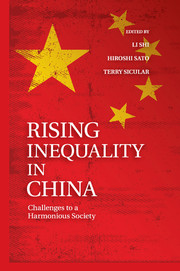Book contents
- Frontmatter
- Contents
- List of Tables
- List of Figures
- Contributors
- Preface
- Abbreviations
- Glossary
- 1 Rising Inequality in China
- 2 Overview
- 3 Housing Ownership, Incomes, and Inequality in China, 2002–2007
- 4 Educational Inequality in China
- 5 Inequality and Poverty in Rural China
- 6 The Evolution of the Migrant Labor Market in China, 2002–2007
- 7 A New Episode of Increased Urban Income Inequality in China
- 8 Unemployment and the Rising Number of Nonworkers in Urban China
- 9 Do Employees in the Public Sector Still Enjoy Earnings Advantages?
- 10 Redistributive Impacts of the Personal Income Tax in Urban China
- 11 Changes in the Gender-Wage Gap in Urban China, 1995–2007
- 12 Intertemporal Changes in Ethnic Urban Earnings Disparities in China
- Appendix I The 2007 Household Surveys
- Appendix II The 2002 and 2007 CHIP Surveys
- Index
- References
9 - Do Employees in the Public Sector Still Enjoy Earnings Advantages?
Published online by Cambridge University Press: 05 July 2013
- Frontmatter
- Contents
- List of Tables
- List of Figures
- Contributors
- Preface
- Abbreviations
- Glossary
- 1 Rising Inequality in China
- 2 Overview
- 3 Housing Ownership, Incomes, and Inequality in China, 2002–2007
- 4 Educational Inequality in China
- 5 Inequality and Poverty in Rural China
- 6 The Evolution of the Migrant Labor Market in China, 2002–2007
- 7 A New Episode of Increased Urban Income Inequality in China
- 8 Unemployment and the Rising Number of Nonworkers in Urban China
- 9 Do Employees in the Public Sector Still Enjoy Earnings Advantages?
- 10 Redistributive Impacts of the Personal Income Tax in Urban China
- 11 Changes in the Gender-Wage Gap in Urban China, 1995–2007
- 12 Intertemporal Changes in Ethnic Urban Earnings Disparities in China
- Appendix I The 2007 Household Surveys
- Appendix II The 2002 and 2007 CHIP Surveys
- Index
- References
Summary
Introduction
Three decades of economic reform have brought tremendous changes in every sector of the Chinese economy. The labor market is no exception, and it was particularly affected by important policy and institutional changes at the turn of the century. On the one hand, the state-sector reform was accelerated after the Chinese Communist Party's Fifteenth National Congress (September 1997), which encouraged both the corporatization of large state-owned enterprises (SOEs) and the restructuring of small SOEs. On the other hand, the Congress also recognized private enterprises as an important component of the economy and placed an emphasis on rule of law. As a direct consequence, the urban labor market was reshaped due to the unprecedented growth in unemployment and the reallocation of labor from the public to the private sector. At the same time, competition among workers in the urban labor market increased sharply due to the massive rural labor-force exodus, which led to an estimated 140 million rural workers in the cities by 2008.
In the context of a transitional economy, these dramatic changes raise a number of issues about the direction of the urban labor market. A key aspect to be explored is whether the labor market has become market oriented and whether enterprises with different ownerships operate competitively. Academic research using data collected from the mid-1990s to the early twenty-first century highlights the incompleteness of the reforms and the “unfinished economic revolution” (Lardy 1998), as well as the remaining rigidities in a segmented labor market with distinct rules for wage determination and limited labor mobility between segments (e.g., Chen, Démurger, and Fournier 2005; Démurger et al. 2006; Dong and Bowles 2002; Knight and Song 2003; Wang 2005).
- Type
- Chapter
- Information
- Rising Inequality in ChinaChallenges to a Harmonious Society, pp. 332 - 361Publisher: Cambridge University PressPrint publication year: 2013



